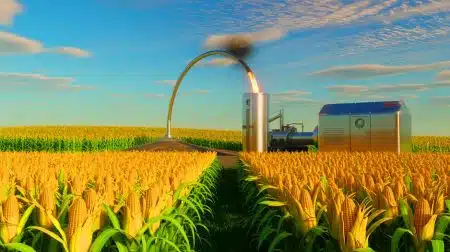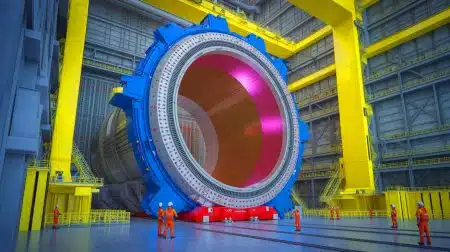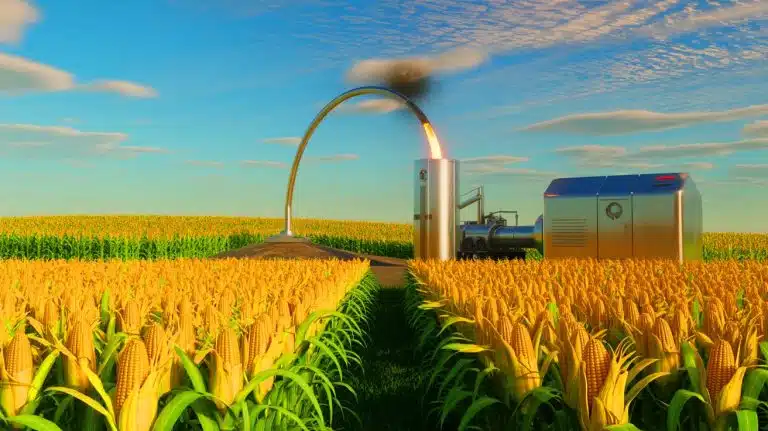| IN A NUTSHELL |
|
The United States stands as a leading global producer of corn, with annual harvests reaching approximately 770 million pounds. This agricultural behemoth, however, leaves behind a significant amount of waste after each harvest. Corn stalks and other residual plant material typically decompose in fields, releasing previously captured carbon dioxide back into the atmosphere. This process not only negates the carbon absorption benefit during the corn’s lifecycle but also contributes to ongoing climate change challenges. Recent research, however, suggests a potential solution by reutilizing these agricultural residues in a manner that could not only mitigate carbon emissions but also solve other environmental issues.
Transforming Waste into Opportunity
Corn, like many plants, absorbs carbon dioxide from the air during its growth cycle. This carbon is stored in various parts of the plant, including the stalks, leaves, and cobs. Post-harvest, these residues are often left to decompose, releasing carbon dioxide back into the atmosphere. The innovative study from Iowa State University proposes interrupting this cycle by transforming these residues using a process known as fast pyrolysis.
Fast pyrolysis involves heating plant material in an oxygen-free environment to over 930°F. The absence of oxygen prevents the material from burning, resulting in three primary products: biochar, syngas, and bio-oil. The biochar can enhance soil fertility, while the gas can fuel the pyrolysis reaction. However, the focus is on the bio-oil, which retains the carbon captured during the plant’s growth.
By injecting this bio-oil into abandoned oil wells, it is believed that the carbon can be securely stored underground for centuries. This process essentially reverses the carbon cycle, returning carbon to where it was originally extracted as fossil fuel. This method not only prevents the release of carbon dioxide but also provides a solution to sealing abandoned oil wells.
The Dual Benefit of Bio-Oil
In the United States, there are approximately 120,000 documented orphan oil wells, with estimates suggesting hundreds of thousands more remain unreported. These wells, often unsealed, continue to emit methane, a greenhouse gas significantly more potent than carbon dioxide over short timescales. The use of bio-oil to fill these wells could simultaneously address methane emissions and provide a means of carbon sequestration.
Researchers estimate the cost of carbon sequestration through this method at around $152 per ton of carbon dioxide. This is comparable to direct air capture projects but requires less infrastructure investment. The possibility of deploying mobile pyrolysis units directly at sites offers a decentralized and potentially more cost-effective solution.
Such versatility makes it an attractive option for carbon credit buyers. According to Peter Reinhardt of Charm Industrial, which supports this research, bio-oil sequestration is considered one of the most reliable and cost-effective methods available. The process also creates biochar, enhancing agricultural productivity by improving soil structure, water retention, and nutrient availability.
Challenges and Future Prospects
While promising, this technique is still in experimental stages. As Mark Mba-Wright, a key researcher, notes, there are numerous hurdles to overcome before widespread implementation. Scaling the process to meet global carbon emissions requires significant advancements and investment.
The potential benefits, however, extend beyond carbon sequestration. Improved soil health from biochar can boost agricultural yields, providing additional income for farmers. Moreover, addressing methane emissions from orphan wells could have an immediate impact on climate change mitigation efforts.
Despite these potential benefits, the overarching challenge remains. The global economy's reliance on cheap, carbon-intensive energy sources continues to drive climate change. While innovative solutions like bio-oil sequestration offer partial relief, they must be part of a broader strategy addressing root causes.
Path Forward and Broader Implications
Integrating agricultural waste reclamation with abandoned oil well management presents a compelling model for sustainable practices. However, it requires cooperation across multiple sectors, including agriculture, energy, and environmental regulation. Stakeholders must collaborate to develop policies that incentivize such practices and invest in necessary technologies.
The potential for bio-oil sequestration highlights an important shift towards circular economy models, where waste is transformed into valuable resources. This aligns with broader sustainability goals and positions agriculture as a pivotal player in climate action.
Yet, the question remains: can these innovative approaches be scaled effectively to make a significant impact on global carbon emissions, or will they remain niche solutions in the fight against climate change?
Did you like it? 4.5/5 (26)







Wait, are they really using corn to fix climate change? 🌽 That’s mind-blowing! 😲
Wow, injecting corn into oil wells? That’s some serious farm-to-well innovation! 🌽🤔
Sounds too good to be true. How scalable is this solution?